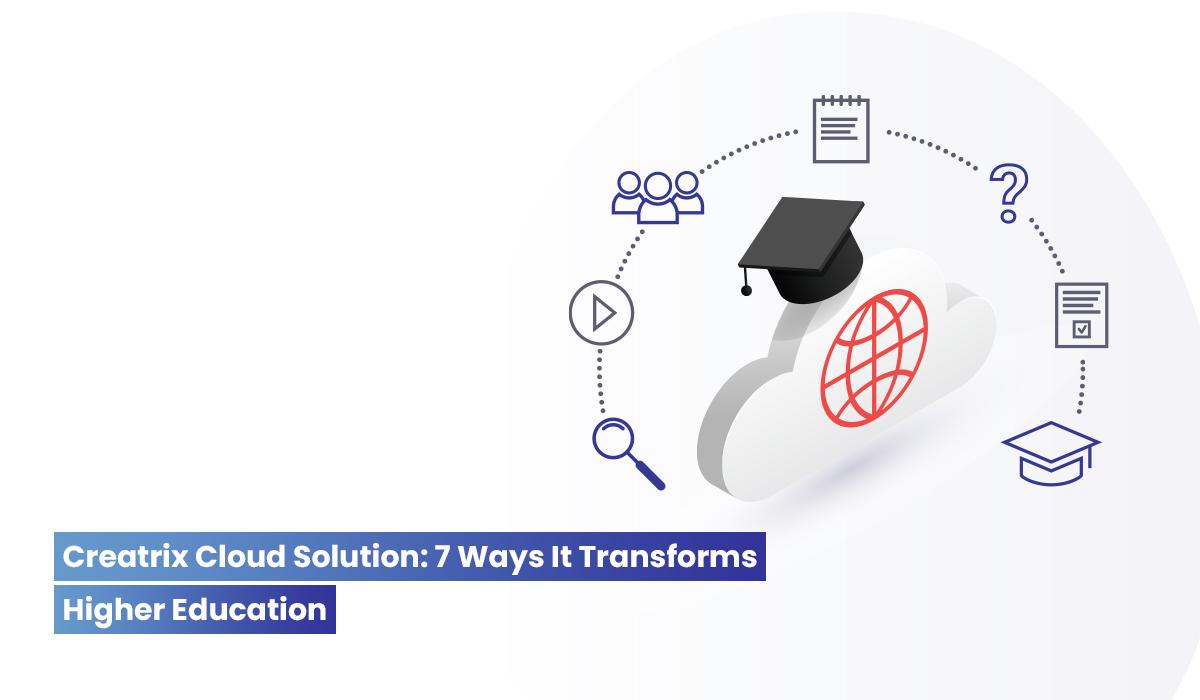Data-Driven Decision Making in Higher Education: Unlocking the Potential of Analytics
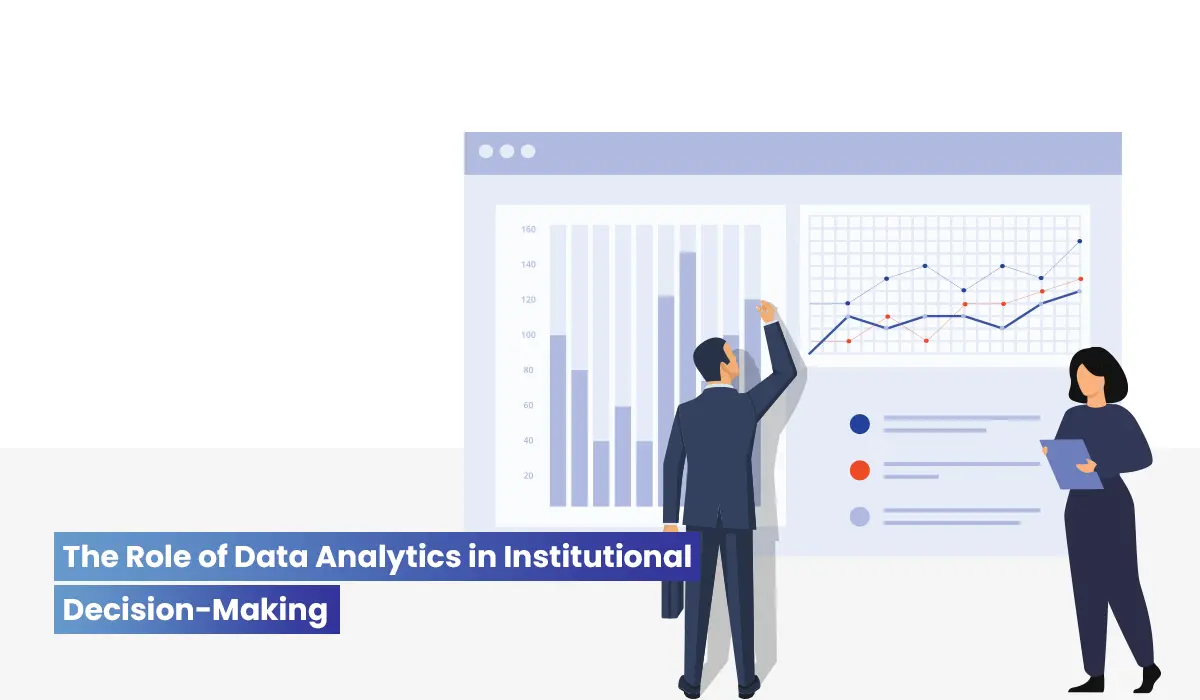
90% of higher education leaders believe that data driven decision making is crucial for institutional success. Forbes Survey.
Data-driven organizations are 23x more likely to gain and 6x more likely to keep customers. McKinsey Global Institute.
Big data users cut costs by 10%. BARC Research.
57% report data-driven marketing boosts ROI. Forbes Survey.
It's clear from the above stats that for higher educational institutions, data driven decision-making has become a game-changer. Both educators and administrators can benefit from the power of data analysis by gaining useful insights that motivate wise choices and improve student outcomes. Let's investigate the value of data analysis in education in this blog article and emphasize its possible advantages for educational specialists.
What is Data-Driven Decision-Making?
Data-Driven Decision-Making, often abbreviated as DDDM, is a strategic approach that relies on the systematic analysis of data to guide organizations and institutions in making informed choices and solving complex problems. In the context of higher education, it involves using data analytics, statistical techniques, and technology tools to collect, process, and interpret data related to various aspects of academic operations, student performance, institutional efficiency, and more.

By leveraging data-driven insights, higher education institutions can enhance their decision-making processes, optimize resource allocation, improve student outcomes, and adapt to evolving challenges and opportunities effectively.
Importance of data driven decision making in higher education
Data-driven decision-making in higher education holds significant importance as it enables institutions to:
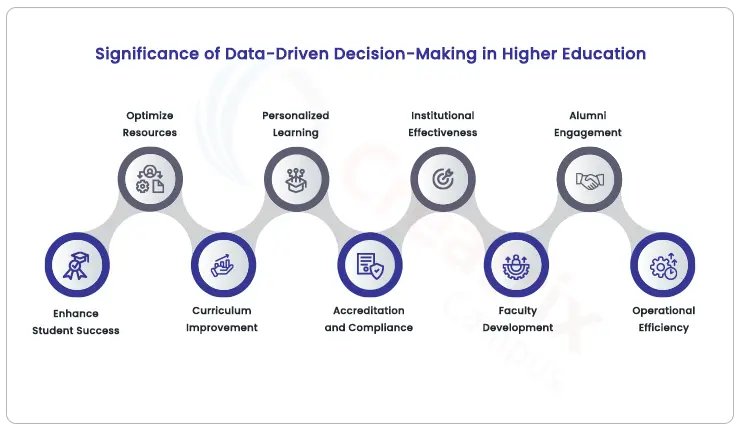
- Identifying at-risk students and enhancing retention.
- Efficient allocation of budgets and staff.
- Improving course offerings and design.
- Tailoring education to individual needs.
- Ensuring adherence to standards.
- Achieving strategic goals and growth.
- Supporting effective teaching practices.
- Strengthening relationships for fundraising.
- Streamlining administrative processes.
- Inspiring new teaching and research approaches.
Role of Data dashboards in higher education
Data dashboards are sophisticated tools that play a crucial role in modern institutions, particularly in higher education. The administrator of higher education may simply track state-by-state admission and fee collection, student enrollment by class, exam results, attendance, etc. with the help of the higher education dashboard. This aids in strategic planning and improves the output from various departments, enabling them to make more educated and data-driven decisions.
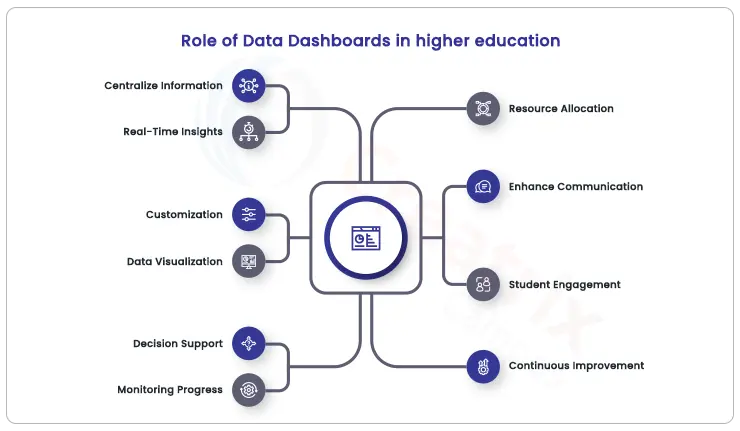
An integrated dashboard offers continuous performance tracking, providing leaders with a valuable tool for keeping governing boards well-informed. This holistic perspective also yields data-driven insights that benefit various stakeholders within the institution:
Presidents: Gain predictive insights into mission priorities, fostering clarity for strategic partnerships, funding opportunities, and collaborations across institutions.
Provosts: Access operational insights related to budget management, research funding, faculty productivity, student risk assessment, academic program analysis, and cost-efficiency.
Chief Financial Officers: Utilize diverse data for real-time and future financial decisions, aiding in cost management and resource allocation.
Deans: Receive insights into academic program diversity, faculty capacity, and potential cost-saving measures within their departments.
Vice Presidents of Research Administration: Access research funding dashboards and grant revenue forecasting, resulting in strategic and operational advantages, and better management of the research organization.
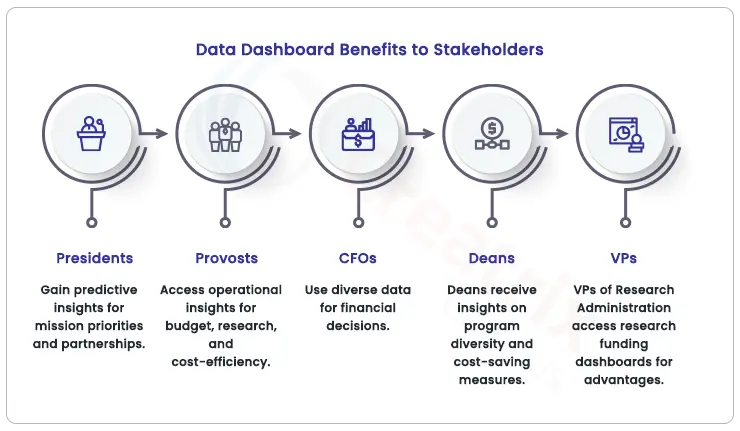
Types of Data Used in Higher Education
Data plays a crucial role in education, helping institutions make informed decisions, improve teaching and learning, and enhance overall efficiency. Several types of data are used in higher education including those related to students, demographics data, academics, behavior, assessments, institution, finance, enrollment, staff, faculty, curriculum, lesson plans, transportation, resource allocation, surveys and feedback, LMS data, attendance, conduct, Individualized Education Programs (IEPs), etc.
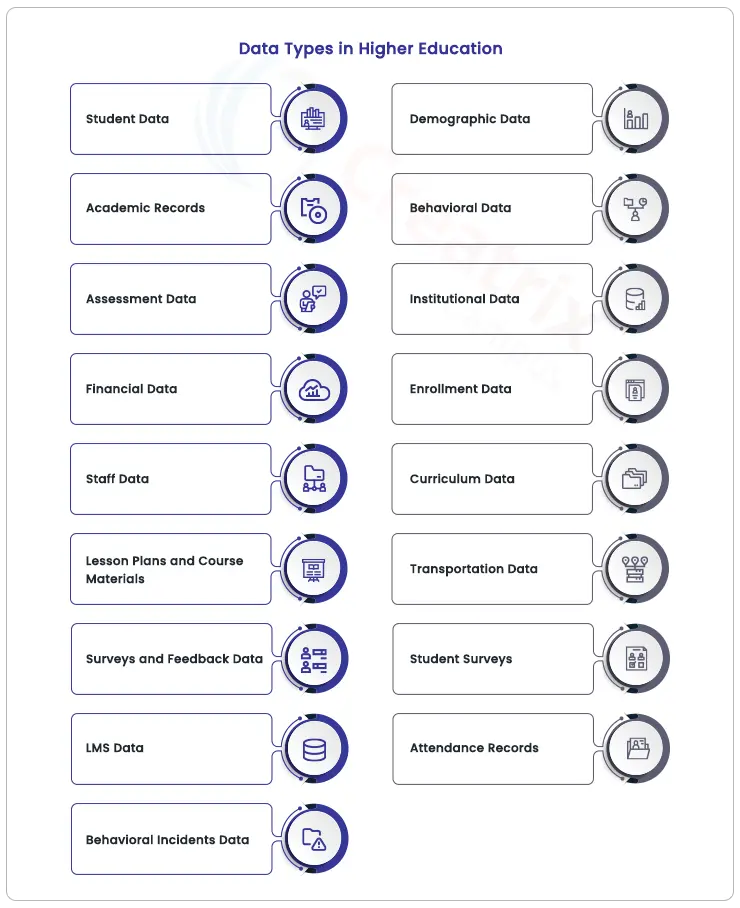
Collating and managing all this manually can become a nightmare. Data management automation can help collate and map tons of data seamlessly, reducing administrative burdens and human errors. With automation tools, educational institutions can streamline data collection, analysis, and reporting processes. This not only saves time and effort but also ensures data accuracy and consistency. Moreover, automation enables real-time data updates, allowing educators to access the most current information to make informed decisions and support student success effectively.
Data Collection and Management Tools in Higher Education
Data collection and management in higher education is a complex process involving various systems, tools, and strategies to gather, organize, and utilize data effectively. Here's an overview of how data collection and management can happen in higher education with a set of software tools from the Creatrix Campus low-code platform:
Admissions and Enrollment Systems
Admissions and Enrollment Systems are essential for collecting, managing, and organizing student data during the enrollment process. These systems capture a wide range of information, including application materials, admission test scores, transcripts, and financial details. By integrating with the Student Information System (SIS), institutions ensure that accurate and up-to-date student records are maintained. This contributes to holistic data management, supporting admissions, enrollment, and student services.
Highlighting Features:
- Streamlined Application Processing
- Document Verification
- Real-time Application
- Tracking Financial Integration
- Enrollment Management
SIS
In the dynamic realm of higher education, the Creatrix Campus Student Information System (SIS) takes center stage as a pivotal tool for effective data management. This comprehensive system not only captures fundamental student data but goes beyond, enabling institutions to gather intricate details of each student's academic journey. Integrated surveys, assessments, and seamless learning management platform compatibility further enhance data insights, equipping institutions for data-driven decision-making, personalized support, and continuous improvement in the ever-evolving educational landscape.
Some of the features that collectively make Creatrix Campus SIS a comprehensive solution for effective data management in higher education institutions include;
Highlighting Features:
- Comprehensive Data Repository
- Real-Time Data Updates
- Data Integration
- Customizable Data Fields
- Data Security
- Reporting and Analytics
- Data Export
- User Permissions
Attendance Management
Similarly, Creatrix Campus Attendance Management seamlessly collects and manages real-time attendance data, which becomes an integral part of the comprehensive student profile within the Student Information System (SIS). This integration empowers institutions to leverage attendance records for data-driven decision-making, trend analysis, and enhancing the educational experience.
Highlighting Features:
- Real-Time Attendance
- Tracking Integration with SIS
- Data-Driven Insights
Student Advising
Creatrix Campus Student Advising takes student guidance to a data-driven level. It enables advisors to track student progress, provide personalized support, and access historical advising records within the Student Information System (SIS). This module facilitates data-informed advising, ensuring that students receive tailored guidance based on their unique academic journeys, contributing to holistic data management.
Highlighting Features:
- Real-time Advising
- Data Holistic Student
- Profiles Personalized Guidance
Learning Management System (LMS)
The Creatrix Campus Learning Management System (LMS) enriches the data collection landscape by seamlessly recording student engagement and performance in online learning environments. This data integration with the Student Information System (SIS) empowers institutions to compile comprehensive student profiles, combining academic records with online learning insights for well-rounded data management.
Highlighting Features:
- Real-time Online Learning Data
- Unified Data Storage
- Streamlined Data Management
Accreditation
Accreditation processes gain efficiency and precision with Creatrix Campus Accreditation. This module streamlines the collection, organization, and reporting of accreditation-related data. By centralizing accreditation records within the Student Information System (SIS), institutions can ensure data accuracy, compliance, and accessibility, ultimately contributing to effective accreditation management and reporting.
Highlighting Features:
- Data Accuracy
- Compliance Tools
- Comprehensive Reporting
Financial Systems
Financial systems in higher education institutions are central to managing financial data efficiently. They collect and organize information related to budgets, expenditures, tuition payments, scholarships, and financial aid disbursements. These systems enable institutions to make data-driven financial decisions and allocate resources effectively. By integrating financial data with the SIS, institutions gain a comprehensive view of the financial aspects of student records, contributing to better financial management.
Highlighting Features:
- Budget Planning
- Expense Tracking
- Scholarship Management
- Billing and Invoicing
- Real-time Financial Reports
Course Evaluation Systems
Course Evaluation Systems are valuable tools for collecting data on student experiences and course effectiveness. These systems gather feedback from students through surveys and evaluations, providing insights into instructional quality and curriculum improvements. The data collected is integrated into the SIS, allowing institutions to assess the impact of teaching methods and make informed decisions to enhance the overall learning experience. This integration supports data-informed course design and delivery.
Highlighting Features:
- Financial Systems
- Customizable Surveys
- Automated Feedback Collection
- Data Visualization
- Integration with SIS
- Historical Data Access
How Educational Institutions Can Harness the Power of Data
Educational institutions can harness the power of data in various ways to enhance student success, improve operations, and make informed decisions. We have represented the same as an image down below.
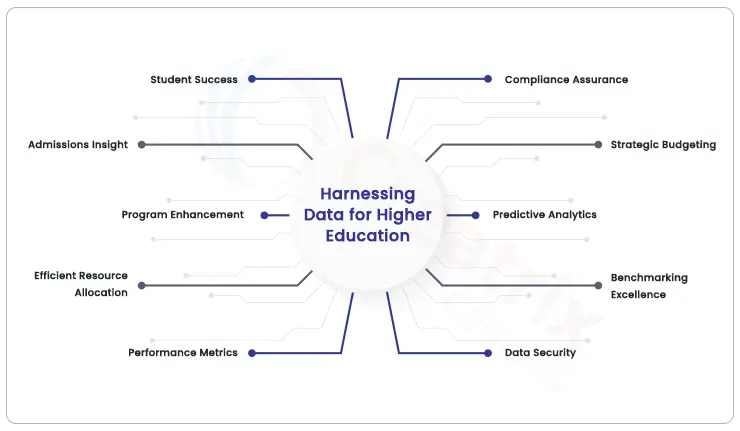
Implementing Data-Driven Decision-Making
Implementing data-driven decision-making in education involves collecting and analyzing data from various sources, using insights to inform decisions and improve processes. Key steps include data collection, analysis, informed decision-making, continuous improvement, monitoring, predictive analytics, compliance, and accountability. It enhances educational quality, student outcomes, and operational efficiency by leveraging data as a valuable resource for informed choices and better outcomes.
Conclusion
The power of data-driven decision-making in higher education cannot be underestimated. As institutions strive for excellence and face myriad challenges, harnessing the potential of analytics is not just an option—it's a necessity. This transformative approach allows decision-makers to chart a course to success with a compass that is accurate, insightful, and forward-looking.
With a commitment to analytics, backed by the right people, processes, and technology, Creatrix Campus ensures institutions stay ahead, fostering innovation and data-driven solutions for years to come.
At Creatrix Campus, we understand the unique demands of the higher education landscape. That's why we've developed higher education-specific modules under Student Success, Learning and Teaching, Institutional Effectiveness, and Faculty Excellence verticals that empower every single personas, institutional head, and decision-maker at your higher ed! Our solutions provide a comprehensive data-driven environment where you can make well-informed choices, ultimately improving student outcomes, resource allocation, and overall institutional effectiveness.
Take the leap and equip your institution with the tools and insights necessary to navigate the complex terrain of higher education, steering toward a brighter, data-empowered future.
Visit the Creatrix Campus website to explore how our modules like SIS, LMS, Faculty Management, Accreditation, Scheduling, and much more can help you unlock the full potential of analytics in higher education. Embrace data, and shape success.


